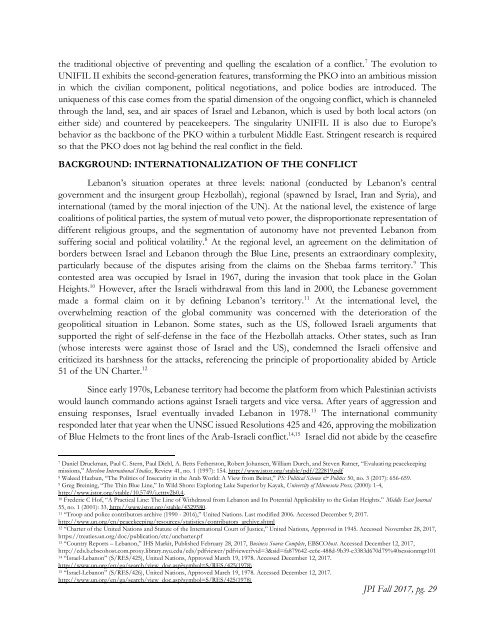Fall 2017 JPI
You also want an ePaper? Increase the reach of your titles
YUMPU automatically turns print PDFs into web optimized ePapers that Google loves.
the traditional objective of preventing and quelling the escalation of a conflict. 7 The evolution to<br />
UNIFIL II exhibits the second-generation features, transforming the PKO into an ambitious mission<br />
in which the civilian component, political negotiations, and police bodies are introduced. The<br />
uniqueness of this case comes from the spatial dimension of the ongoing conflict, which is channeled<br />
through the land, sea, and air spaces of Israel and Lebanon, which is used by both local actors (on<br />
either side) and countered by peacekeepers. The singularity UNIFIL II is also due to Europe’s<br />
behavior as the backbone of the PKO within a turbulent Middle East. Stringent research is required<br />
so that the PKO does not lag behind the real conflict in the field.<br />
BACKGROUND: INTERNATIONALIZATION OF THE CONFLICT<br />
Lebanon’s situation operates at three levels: national (conducted by Lebanon’s central<br />
government and the insurgent group Hezbollah), regional (spawned by Israel, Iran and Syria), and<br />
international (tamed by the moral injection of the UN). At the national level, the existence of large<br />
coalitions of political parties, the system of mutual veto power, the disproportionate representation of<br />
different religious groups, and the segmentation of autonomy have not prevented Lebanon from<br />
suffering social and political volatility. 8 At the regional level, an agreement on the delimitation of<br />
borders between Israel and Lebanon through the Blue Line, presents an extraordinary complexity,<br />
particularly because of the disputes arising from the claims on the Shebaa farms territory. 9 This<br />
contested area was occupied by Israel in 1967, during the invasion that took place in the Golan<br />
Heights. 10 However, after the Israeli withdrawal from this land in 2000, the Lebanese government<br />
made a formal claim on it by defining Lebanon’s territory. 11 At the international level, the<br />
overwhelming reaction of the global community was concerned with the deterioration of the<br />
geopolitical situation in Lebanon. Some states, such as the US, followed Israeli arguments that<br />
supported the right of self-defense in the face of the Hezbollah attacks. Other states, such as Iran<br />
(whose interests were against those of Israel and the US), condemned the Israeli offensive and<br />
criticized its harshness for the attacks, referencing the principle of proportionality abided by Article<br />
51 of the UN Charter. 12<br />
Since early 1970s, Lebanese territory had become the platform from which Palestinian activists<br />
would launch commando actions against Israeli targets and vice versa. After years of aggression and<br />
ensuing responses, Israel eventually invaded Lebanon in 1978. 13 The international community<br />
responded later that year when the UNSC issued Resolutions 425 and 426, approving the mobilization<br />
of Blue Helmets to the front lines of the Arab-Israeli conflict. 14,15 Israel did not abide by the ceasefire<br />
7 Daniel Druckman, Paul C. Stern, Paul Diehl, A. Betts Fetherston, Robert Johansen, William Durch, and Steven Ratner, “Evaluating peacekeeping<br />
missions,” Mershon International Studies, Review 41, no. 1 (1997): 154. http://www.jstor.org/stable/pdf/222819.pdf<br />
8 Waleed Hazbun, “The Politics of Insecurity in the Arab World: A View from Beirut,” PS: Political Science & Politics 50, no. 3 (<strong>2017</strong>): 656-659.<br />
9 Greg Breining, “The Thin Blue Line,” In Wild Shore: Exploring Lake Superior by Kayak, University of Minnesota Press, (2000): 1-4,<br />
http://www.jstor.org/stable/10.5749/j.ctttv2b0.4.<br />
10 Frederic C Hof, “A Practical Line: The Line of Withdrawal from Lebanon and Its Potential Applicability to the Golan Heights.” Middle East Journal<br />
55, no. 1 (2001): 33, http://www.jstor.org/stable/4329580.<br />
11 “Troop and police contributors archive (1990 - 2016),” United Nations. Last modified 2006. Accessed December 9, <strong>2017</strong>.<br />
http://www.un.org/en/peacekeeping/resources/statistics/contributors_archive.shtml<br />
12 “Charter of the United Nations and Statute of the International Court of Justice,” United Nations, Approved in 1945. Accessed November 28, <strong>2017</strong>,<br />
https://treaties.un.org/doc/publication/ctc/uncharter.pf<br />
13 “Country Reports – Lebanon,” IHS Markit, Published February 28, <strong>2017</strong>, Business Source Complete, EBSCOhost. Accessed December 12, <strong>2017</strong>,<br />
http://eds.b.ebscohost.com.proxy.library.nyu.edu/eds/pdfviewer/pdfviewer?vid=3&sid=fa879642-ee6c-488d-9b39-e3383d670d79%40sessionmgr101<br />
14 “Israel-Lebanon” (S/RES/425), United Nations, Approved March 19, 1978. Accessed December 12, <strong>2017</strong>.<br />
http://www.un.org/en/ga/search/view_doc.asp?symbol=S/RES/425(1978)<br />
15 “Israel-Lebanon” (S/RES/426), United Nations, Approved March 19, 1978. Accessed December 12, <strong>2017</strong>.<br />
http://www.un.org/en/ga/search/view_doc.asp?symbol=S/RES/425(1978)<br />
<strong>JPI</strong> <strong>Fall</strong> <strong>2017</strong>, pg. 29
















